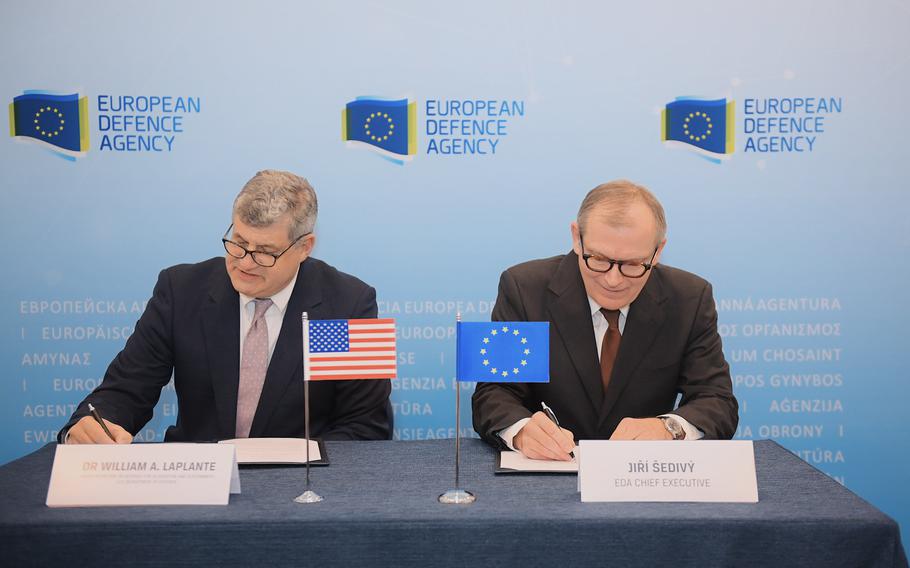
European Defence Agency Chief Executive Jiří Šedivý, right, and U.S. Undersecretary of Defense for Acquisition and Sustainment William LaPlante sign an administrative agreement in Brussels, Belgium, on Wednesday, April 26, 2023, that aims to deepen security ties and expand communication and cooperation among the United States and nations of the European Union. (European Defence Agency)
WASHINGTON — The Pentagon and the European Union on Wednesday announced a transatlantic agreement to strengthen defense cooperation and share more information with each other — moves that both say are important now that war has returned to the Continent.
"The signature of the administrative arrangement with [the European Defence Agency] is evidence of the strengthening U.S.-European Union relationship,” Defense Secretary Lloyd Austin said, noting it will “further contribute to transatlantic and global security.”
One of the benefits of expanding dialogue and the flow of information is it could identify areas where resources could be pooled and wasteful defense spending can be limited, according to the agreement. It specifies that there will be more cooperation in certain areas such as defense supply chains, troop mobility and the security impacts of climate change.
“The [agreement] will enable a substantial defense dialogue on all topics within EDA's remit, and invitations for [Pentagon leaders] to attend relevant meetings of EDA's steering board and for EDA to attend meetings convened by the U.S. DOD, as appropriate,” the Defense Department and EDA said in a joint statement.
Wednesday’s agreement also allows the U.S. to participate in certain EU defense meetings and consult on certain issues, such as “military mobility,” officials said. The nine-page document applies to all 24 EU members plus third-party partners Norway, Serbia, Switzerland and Ukraine.
The pact is mainly the result of a pledge two years ago by both sides to come up with an agreement for a “closer and mutually beneficial cooperation.” Since then, tens of thousands of people have died during Russia’s war in Ukraine, which makes Wednesday’s agreement even more important, they said.
“Russia's aggression against Ukraine underlines the importance of strong U.S.-European ties in NATO and with the European Union,” Austin said. “Deepening dialogue and cooperation will only strengthen this key strategic partnership moving forward."
“At a time when war has returned to Europe, we need to open every avenue for cooperation with our closest partners,” Borrell said. “[This] provides another pillar to strengthen transatlantic cooperation.”
The agreement, however, explicitly states the U.S. and EU are not allowed to cooperate on the research and development of defense technologies. However, the scope of the agreement could “progressively develop in the future.”